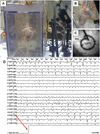Time- and frequency-domain analyses of atrial fibrillation activation rate: the optical mapping reference
- PMID: 21699849
- PMCID: PMC3202688
- DOI: 10.1016/j.hrthm.2011.05.007
Time- and frequency-domain analyses of atrial fibrillation activation rate: the optical mapping reference
Abstract
Background: Time- and frequency-domain estimates of activation rate have been proposed to guide atrial fibrillation (AF) ablation in patients, but their electrophysiological correlates are unclear.
Objective: This study sought to examine the relative correlation of average electrical cycle length (CL) and dominant frequency (DF) during AF with reference optical mapping measures.
Methods: Eight sheep hearts were Langendorff-perfused and superfused with oxygenated Tyrode solution inside a tank representing the human thorax. Optical mapping (DI-4-ANEPPS) of 4 × 4 cm2 in the left atrium was performed at 0.5 mm/pixel and 600 fps. A 20-pole catheter was placed in the optical field of view to acquire 1.2-kHz unipolar recordings by the EnSite NavX System (ENS; St. Jude Medical, St. Paul, MN) optimized for CL and DF calculation. During AF, 5-second-long simultaneous optical and electrical signals were analyzed for CL and DF.
Results: During pacing, DF measurements had fewer false results than CL (6.6% to 2.5% vs. 21.5% to 4.4% depending on filtering, P <.001). During AF in regions showing periodic waves on both sides of the catheter optical 1,000/CL versus DF correlation showed 95% confidence identity and was better than unipolar measurements in the ENS (adjusted R(2): 0.58879 vs. 0.12902; P < 10(-6)). DFs of unipolar signals correlated better than CLs with DFs of optical signals. Similarly, bipolar DF correlation with optical DF was not different from identity (P >.157), but the bipolar CL showed smaller identity with the optical CL (P <.0004).
Conclusion: DF values of unipolar and bipolar signals correlate with those of optical signals better than CL values for the respective signals.
Copyright © 2011 Heart Rhythm Society. Published by Elsevier Inc. All rights reserved.
Figures







Comment in
-
Time- and frequency-domain analysis of AF electrograms: simple approaches to a complex arrhythmia?Heart Rhythm. 2011 Nov;8(11):1766-8. doi: 10.1016/j.hrthm.2011.06.006. Epub 2011 Jun 7. Heart Rhythm. 2011. PMID: 21699866 No abstract available.
References
-
- Haissaguerre M, Sanders P, Hocini M, et al. Changes in atrial fibrillation cycle length and inducibility during catheter ablation and their relation to outcome. Circulation. 2004;109(24):3007–3013. - PubMed
-
- Takahashi Y, Jais P, Hocini M, et al. Shortening of fibrillatory cycle length in the pulmonary vein during vagal excitation. J Am Coll Cardiol. 2006;47(4):774–780. - PubMed
-
- Sanders P, Berenfeld O, Hocini M, et al. Spectral analysis identifies sites of high-frequency activity maintaining atrial fibrillation in humans. Circulation. 2005;112(6):789–797. - PubMed
-
- Nademanee K, McKenzie J, Kosar E, et al. A new approach for catheter ablation of atrial fibrillation: Mapping of the electrophysiologic substrate. Journal of the American College of Cardiology. 2004;43(11):2044–2053. - PubMed
Publication types
MeSH terms
Grants and funding
LinkOut - more resources
Full Text Sources
Other Literature Sources
Medical
Miscellaneous

